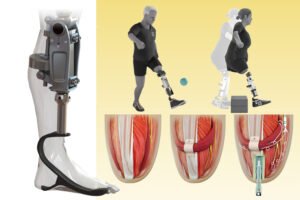Researchers at MIT Media Lab are redefining the intersection of human physiology and robotics. Everett Lawson has developed a bionic leg that converts muscle signals directly into movement, enabling users to control the prosthetic limb almost as naturally as their own body. This technology effectively translates thought into action, a major leap in human-robot integration.
 Innovation Details
Innovation Details
The bionic leg uses advanced sensors to detect electromyographic (EMG) signals from the wearer’s muscles. These signals are then processed in real-time to drive precise leg movement, allowing users to perform complex motions without conventional mechanical controls. By integrating biological signals directly into robotic control, this system bridges the gap between human intent and machine execution.
This approach represents a significant advancement in assistive technology, offering unprecedented mobility for individuals with limb loss or mobility impairments.
 Implications & Future Prospects
Implications & Future Prospects
This breakthrough opens exciting possibilities in cybernetic enhancement and bio-integrated robotics, including:
-
Enhancing prosthetic functionality to match natural limb behavior.
-
Developing next-generation wearable robotics for rehabilitation and mobility support.
-
Advancing human-machine symbiosis in areas like industrial exoskeletons and performance augmentation.
The research hints at a future where thought-driven robotics could seamlessly integrate with human physiology, extending the capabilities of the human body while maintaining intuitive control.
Video Credit: MIT Media Lab / Bloomberg



